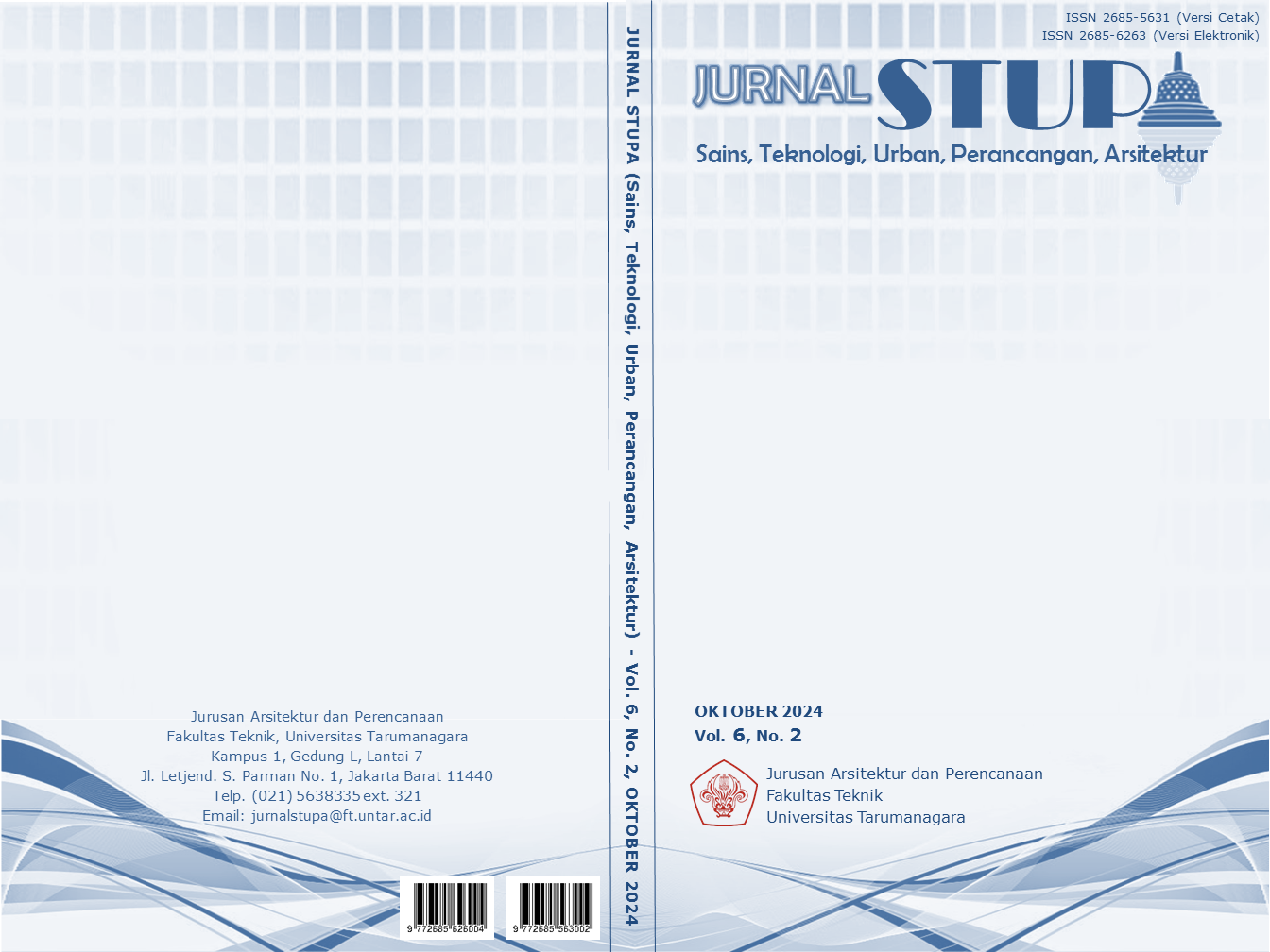STRATEGI DESAIN DALAM BANGUNAN KOMERSIAL TERINTEGRASI STASIUN KEBAYORAN
Main Article Content
Abstract
Kebayoran Lama Utara Subdistrict has various kinds of facilities, for example Kebayoran Lama Market and Kebayoran Station. In the past, this area was a trading center for the surrounding community and continues to grow. Nowadays, the phenomena of physical degradation (changes in building conditions) and land function degradation (changes in trading activities) are starting to occur in this area. As a result, the surrounding commercial buildings experienced a decline and the Kebayoran area began to lose its identity as a trading center area. When a place has no identity, then the place has no sense of place or ties to people. This can be said to be placelessness (Relph, 1976). Based on data and studies, the Kebayoran Lama area is called a placeless place, where the place does not have a sense of place which includes the identity of the place itself. Therefore, architecture exists as an intervention in regional phenomena and issues, one form of which is a design strategy to strengthen the identity of the Kebayoran Lama area. Qualitative research methods supported by primary and secondary data collection were used to obtain this strategy. The research results show that the design strategy that can be implemented is through optimizing the function and redevelopment methods of the Kebayoran Station integrated commercial building. Redevelopment was carried out by dismantling the entire building to optimize the function program. The proposed program functions as a solution to the issue of placeless places and supports regional facilities including supermarkets, department stores, food courts and tenants.
Keywords: Kebayoran Lama; placeless; redevelopment; Stasiun Kebayoran
Abstrak
Kelurahan Kebayoran Lama Utara memiliki berbagai macam fasilitas, contohnya seperti Pasar Kebayoran Lama dan Stasiun Kebayoran. Pada masa lalu, kawasan ini menjadi wilayah pusat perdagangan bagi masyarakat sekitar dan terus berkembang. Pada masa kini, fenomena degradasi fisik (perubahan kondisi bangunan) dan degradasi fungsi lahan (perubahan aktivitas perdagangan) mulai terjadi di kawasan ini. Dampaknya, bangunan komersial di sekitarnya mengalami penurunan dan kawasan Kebayoran mulai kehilangan identitasnya sebagai wilayah pusat perdagangan. Ketika tempat tidak memiliki identitas, maka tempat tidak memiliki sense of place atau ikatan dengan manusia. Hal tersebut dapat dikatakan sebagai placelessness (Relph, 1976). Berdasarkan data dan studi, kawasan Kebayoran Lama disebut dengan placeless place di mana tempat tidak memiliki sense of place yang mencakup identitas dari place itu sendiri. Oleh karena itu, arsitektur hadir sebagai intervensi terhadap fenomena dan isu kawasan, salah satu bentuknya yaitu strategi desain untuk memperkuat identitas kawasan Kebayoran Lama. Metode penelitian kualitatif didukung pengumpulan data primer maupun sekunder digunakan untuk mendapatkan strategi tersebut. Hasil penelitian menunjukkan bahwa strategi desain yang dapat dilakukan yaitu melalui optimalisasi fungsi dan metode redevelopment bangunan komersial terintegrasi Stasiun Kebayoran. Pembangunan kembali dilakukan dengan membongkar keseluruhan bangunan untuk mengoptimalkan program fungsi. Usulan program fungsi menjadi solusi isu placeless place dan pendukung fasilitas kawasan meliputi supermarket, department store, foodcourt, dan tenant.
Article Details

This work is licensed under a Creative Commons Attribution-NonCommercial-ShareAlike 4.0 International License.
This work is licensed under a Jurnal Sains, Teknologi, Urban, Perancangan, Arsitektur/ STUPA Creative Commons Attribution-NonCommercial-ShareAlike 4.0 International LicenseReferences
Dewi, Sukma. (2024, Januari). Stasiun Kebayoran Lama: Sejarah Singkat, Lokasi, dan Fasilitas di Dalamnya. Diakses dari https://blog.cove.id/stasiun-kebayoran-lama/
Dwi, Andi Annisa. (2023, Januari). Pasar Kebayoran Lama Ada Sejak 1850, Ini Keramaiannya Sekarang. Diakses dari https://food.detik.com/berita-boga/d-6538395/pasar-kebayoran- lama-ada-sejak-1850-ini-keramaiannya-sekarang
Febriana, F., & Herlambang, S. (2020). EKSPLORASI MIXED-PROGRAM (PASAR BUNGA, KULINER, DAN TAMAN KOTA) DALAM MERANCANG 3 FLORE KEBAYORAN LAMA, JAKARTA SELATAN. Jurnal Sains, Teknologi, Urban, Perancangan, Arsitektur (Stupa), 2(2), 1367-1382.
Heldasari, H., & Anhar, P. (2020). Peremajaan Kawasan Pasar Bauntung Banjarbaru (Redevelopment). JURNAL TUGAS AKHIR MAHASISWA LANTING, 9(2), 40-47.
Martin, J., Rahardjo, P., & Santoso, S. (2020). STUDI TRANSFORMASI PASAR TRADISIONAL (OBJEK STUDI: PASAR KEBAYORAN LAMA, KELURAHAN KEBAYORAN LAMA UTARA, KECAMATAN KEBAYORAN LAMA, JAKARTA SELATAN). Jurnal Sains, Teknologi, Urban, Perancangan, Arsitektur (Stupa), 2(2), 2631-2642.
Meliansari, S. R., & Ellisa, E. THE PLACELESSNESS OF KAMPUNG KAPITAN PALEMBANG: CAGAR BUDAYA DI AMBANG KEHANCURAN. MODUL, 23(1), 50-59.
Mirsa, R., & Yati, Z. F. (2020). Kajian Sense of Place Pada Koridor Pasar Tomok Kabupaten Samosir. Senthong, 3(1).
Relph, E. (1997). Sense of place. Ten geographic ideas that changed the world, 205-226.
Sasanto, R., & Yusuf, M. (2010). Identifikasi karakteristik pasar tradisional di wilayah Jakarta Selatan (Studi kasus: pasar Cipulir, pasar Kebayoran Lama, pasar Bata Putih, dan pasar Santa). Jurnal Planesa, 1(1).
Seamon, D., & Sowers, J. (2008). Place and Placelessness, Edward Relph. Key texts in human geography, 43, 51.
Tanuwijaya, R., & Trisno, R. (2020). Loka Loak Kebayoran Lama. Jurnal Sains, Teknologi, Urban, Perancangan, Arsitektur (Stupa), 2(2), 1231-1244.
Timalsina, K. P. (2021). People, place, and space: Theoretical and empirical reflections in studying urban open space. Geographical Journal of Nepal, 14, 171-188.
Tuan, Y. F. (1979). Space and place: humanistic perspective. In Philosophy in geography (pp. 387-427). Dordrecht: Springer Netherlands.



